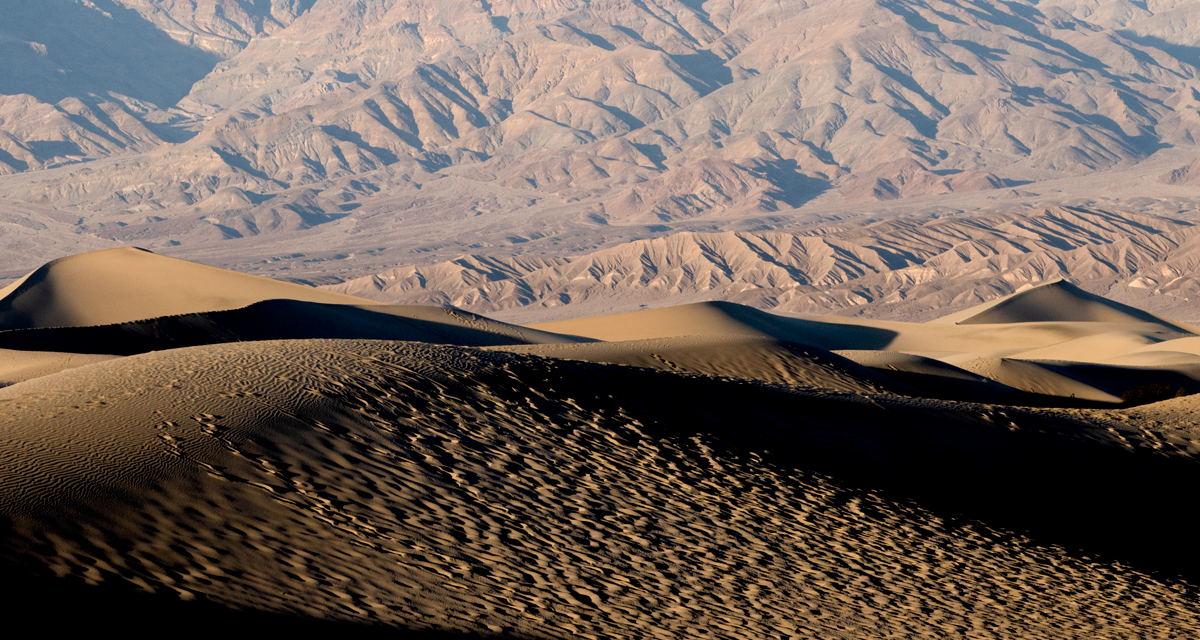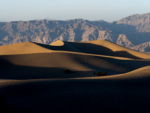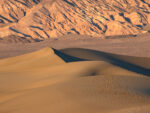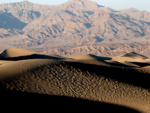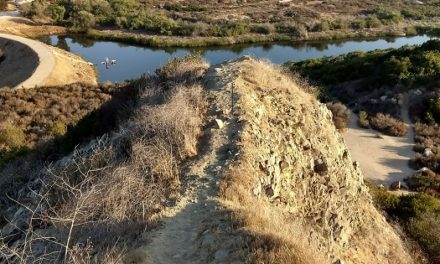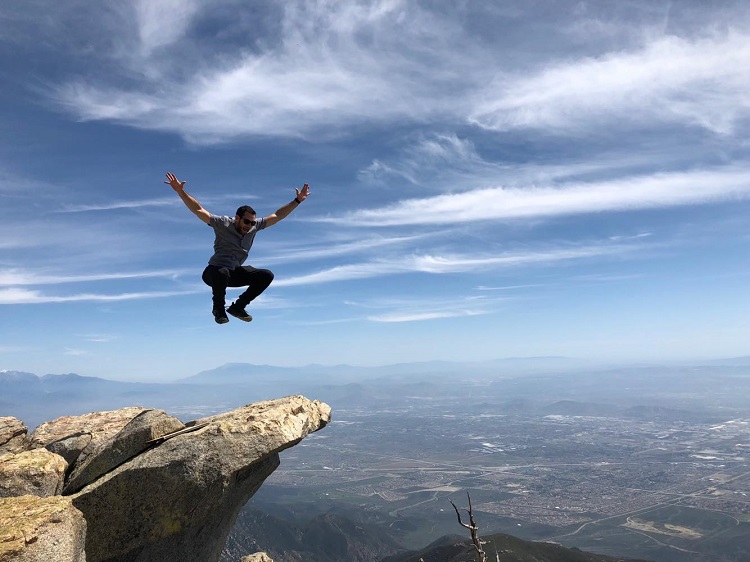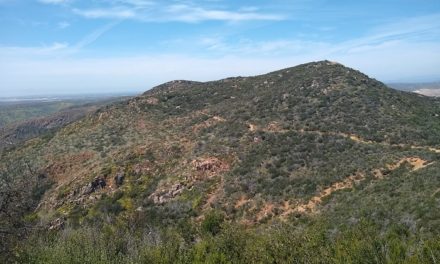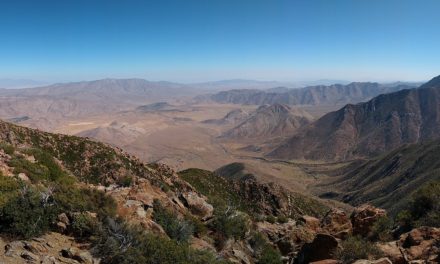Mesquite Flat Sand Dunes Hiking Guide – Death Valley National Park
Of all the things to do in Death Valley National Park visiting a natural sand dune is one of the things that should be at the top of everybody’s list. Mesquite Flat Sand Dunes is a large area of natural ivory colored sand near the tourist stopping point of Stovepipe Wells. These dunes are a popular attraction most visitors coming to Death Valley. Some of the highlights about Mesquite Flat Sand Dunes is that they’re the easiest dunes to access inside the park, they provide some very beautiful shadows and colors, and the proximity of the dunes to Stovepipe wells. The dunes themselves cover fourteen square miles across the broadest part of the valley (1). As you walk across the dunes, keep an eye out for the twisted mesquite trees scattered throughout the dunes which give them their name.
One might be wondering just why exactly there aren’t more sand dunes in the desert. The creation of dunes is a complicated process that requires three things: a supply of sand (obvious), strong wind, and something to slow the wind so the sand builds up and stays in one location. In the case of Mesquite Flat Sand Dunes, winds from the north blow in eroding sand from surrounding mountains. The winds bring the sand down to the south to the base of the large Panamint mountain range. The sand builds and is distributed throughout a large basin north of the mountains. On the west side of the Panamint mountains, southerly winds blow in even more sand from the other direction. As a result, sand builds up across a large area throughout the valley and is kept in place from surrounding mountains (2).
On A Personal Note:
Mesquite Flat Sand Dunes is a wonderful place to spend time photographing some beautiful colors. Depending on the time of day you can capture dramatic shadows or soft pastels. One of the most beautiful times to visit is during the evening to watch the sun set across the valley. This is also a great place for children to roam free with the soft sand to help keep them safe from any major hazards. However, at night major threats will be foxes, coyotes, and rattlesnakes.
A couple of things to note: There is no actual trail here. You’re free to create your own path. Walking in sand is a lot more difficult than walking on flat compact soil. If you happen to be visiting outside of the dusk or dawn hours, stay well hydrated and bring sunscreen. The bright white colors reflect the sunlight generating more heat that radiates against your skin.
Looking for another short hike nearby? Check out Mosaic Canyon. This trail is also near Stovepipe Wells. It’s popular for its vibrant colors through a narrowed canyon through the base of Tucki Mountain on the north end of the Panamint Range.
Sources:
1. N.a. “Mesquite Flat Sand Dunes.” Death Valley National Park. National Park Service Placard. Exhibited at Mesquite Flat Sand Dunes February 2021.
2. N.a. “Sand Trap.” Death Valley National Park. National Park Service Placard. U.S. Department Of The Interior. Exhibited at Mesquite Flat Sand Dunes February 2021.
- Overall Difficulty: 30%
- Overall Views: 100%
Mesquite Flat Sand Dunes Trail Quick Facts:
- Max Elevation: -16 feet.
- Elevation Gain: 16 feet.
- Estimated Distance: as far as you want.
- My Actual Distance: 0.9 miles.
- Estimated Time: 15-45 minutes.
- My Time: 31 minutes.
Mesquite Flat Sand Dunes Trail Directions:
Mesquite Flat Sand Dunes Trail Pictures:
- The Mesquite Flat Sand Dunes. This is the tallest dune in the foreground about a mile in distance from the parking lot. Don’t be fooled by the solitude; many people were photoshopped out.
- Soft pastel hues during golden hour at Mesquite Flat Sand Dunes National Park.
- During the time of day where the son is at a low angle the dunes cast some beautiful shadows.
Who Mesquite Flat Sand Dunes Trail Is For:
Advanced Hikers: The sand makes this area difficult for exploring longer distances here. Choose your own adventure.
Expert Hikers: If you want to find some dunes without any fresh footprints or people, this is a great trail to do. Set out towards the northeast in the direction of the dunes. Don’t forget to bring a camera.
It’s always a good idea to be aware of what type of hiking level you’re at.
Best Time Of Year To Hike Mesquite Flat Sand Dunes Trail:
Late fall to late winter is the best time to visit this trail as far as temperatures are concerned. Morning and evening temperatures will be cool. Daytime highs will be mild. However, nighttime temperatures can be below freezing or near freezing. Outside of those months the temperatures warm up little by little during the day and the nights begin to warm as well. The late fall to early spring will have cold morning temperatures with warm daytime highs. Keep in mind that the dunes reflect a lot of heat and ultraviolet light. Those who are prone to skin damage from UV light would be wise to wear adequate sun protection while out along the dunes.
Once April-October comes around it is just hot. Overnight lows will remain warm, even hot during the middle of the summer. The middle of the summer is one of the hottest places on the entire planet and significant outdoor activity isn’t really recommended. Those who are sensitive to heat are advised to be out during the cooler hours of the morning or not at all. Summer can bring about other problems besides just heat. The summer months is the monsoon season for the southwest desert. This season brings about the chance for lightning and thunderstorms. Avoid being out in the open during a thunderstorm to prevent being hit by lightning.
It’s always a good idea to check the weather before heading out on a hike.
Mesquite Flat Sand Dunes Trail Conditions:
The trail condition is – there is no trail at the Mesquite Flat Sand Dunes! You are free to roam about wherever you want and as far as you want. Create your own adventure. The further out you wander the more difficult this area will be. Walking on sand is more difficult than walking on compacted and hardend ground. If you do wander away from the parking lot, make sure to keep its orientation in your mind so you don’t get lost.
Keep an eye out for rattlesnakes. They can be out during the warmer periods of the day during the winter and during the cooler night temperatures during the hotter months. If you’re out during dawn, dusk, or during the night and have children, keep an eye out for native predators such as foxes and coyotes.

